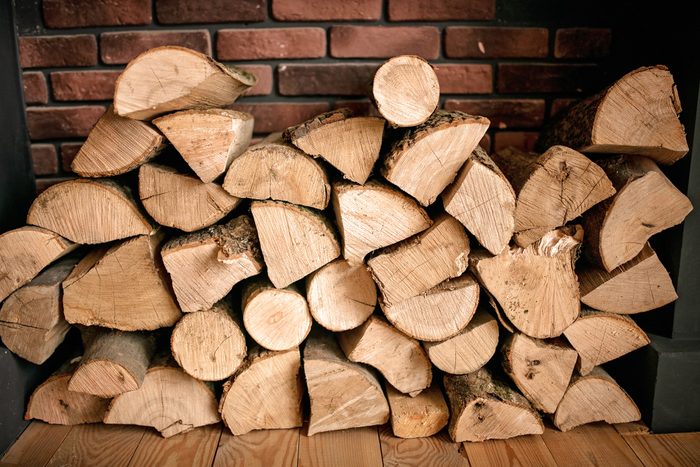Hardwood vs. Softwood: Which Is Best for Firewood?
Updated: Feb. 27, 2023

Unsure if hardwood or softwood is better for your fire-building needs? The answer depends on the fire's location and purpose.
Is hardwood or softwood better for building a fire? The answer largely depends on where you’re building the fire and what you’re using it for. Cooking? Home heating? Or just warming up a campsite?
We’ve simplified the answers for you in this firewood guide to hardwood vs. softwood so you can find the best firewood for heating and other situations.
On This Page
What is Hardwood?
Hardwoods are broadly a category of slow-growing trees that produce dense wood. Hardwood trees are usually deciduous, meaning they drop their leaves in the fall and sprout new ones in the spring.
Hardwoods typically used for firewood include oak, ash and birch, while walnut, maple and mahogany are prized for furniture-making. With almost any hardwood, the density of the wood means it burns longer and produces more heat compared to softwood. And here’s something you might not know about hardwood — it all comes from flowering trees!
What is Softwood?
Softwood comes from gymnosperm trees, or those with external un-incased seeds. By far the most common of softwoods are conifers, or cone-producing trees. Softwoods are less dense than almost all varieties of hardwood.
Because softwoods grow much faster than hardwoods, they’re used in all sorts of manufacturing, including in the paper and construction industries. For firewood, the most commonly burned softwoods include fir, pine, spruce and cedar.
When To Use Hardwood Firewood
The short answer is, almost all the time. That’s mostly because softwood is such a poor alternative for so many uses. Here are all the circumstances where hardwood is the better choice than softwood:
- Indoor fireplace. Softwood burns faster and gives off a lot more smoke than hardwood. Even if you light your indoor fireplace more for the ambiance than heating, softwood will smoke up your house and leave behind a resin that will build up in your fireplace and chimney. So make sure you’re familiar with these expert tips on the safety of indoor fireplaces.
- Cooking campfire. “Due to the sap content which makes for a smoky burn, softwood is not good to cook over,” says Tim Connelly, product engineer for BioLite. “That smoke will stick to the food and be unpleasant to both the eyes and taste buds! Hardwood is the way to go for cooking. I prefer oak and cherry for their higher density and the flavor imparted on the food.”
- Wood stove. Don’t use softwood in your wood stove for the same reasons as an indoor fireplace. Even if your stove emits little or no smoke inside the house, the resin in the wood will eventually gum up the stove and chimney. And softwood burns so quickly it’s not efficient for heating.
- Wood-burning furnace. As with a wood stove, burning softwood just isn’t an efficient way to heat a home or cabin. It’s especially hard to keep a softwood fire burning all night — unless, that is, you like getting out of bed repeatedly to toss in more logs. Resin buildup is also an issue.
- Wood-fired saunas and hot tubs. Unless you love the smell of pine or cedar during your sauna session, most experts recommend hardwood to heat your wood-burning sauna. You might use some softwood kindling to get the fire going faster, but that’s all. For wood-fired hot tubs, a mix of softwood and hardwood will heat the water fast and keep it nice and toasty.
When To Use Softwood Firewood
Softwood firewood can be burned in outdoor fires that aren’t used for cooking anything larger than a roasted marshmallow or two. It’s also a good choice for starting a fire. “Softwood makes a great fire starter due to the sap content,” says Connelly. “I keep a bundle of cedar shingles in my garage just for that purpose.”
- Backyard fire pit. Softwood is fine for a backyard fire pit that’s just there for looks, a little warmth and a gathering spot to enjoy a few beverages. Some softwoods, like cedar and piñon pine, give off a pleasant scent when burned.
- Wilderness campfire. Your wilderness campfire might include dried wood provided at a campsite or fallen wood you gather. If you’re not cooking over the fire, softwoods are okay to burn in a campfire ring. But watch how close you get, Connelly says, and keep an eye on the fire. “Softwoods often produce large embers that pop far from the fire, elevating fire danger,” he says. “Also, nobody likes holes burned in their fleece or down puffy jacket.”
More Firewood Tips
Here are a few more things to keep in mind when ordering firewood or deciding what kind of wood to burn. There are some types of firewood not to burn.
Never burn treated wood. Pressure treated, painted, stained or composite wood should never be burned indoors or outdoors because it can emit toxic fumes. If you’re burning old construction wood, be sure to remove any nails or screws before tossing it in the fire.
